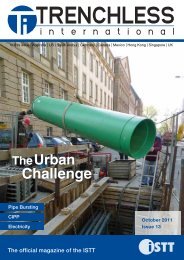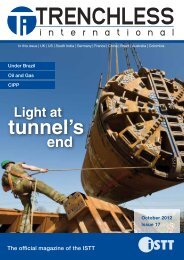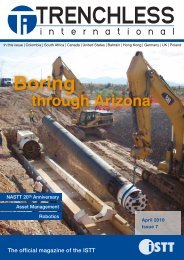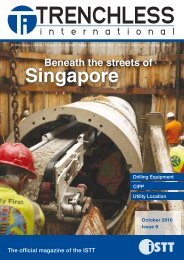North American Special - Trenchless International
North American Special - Trenchless International
North American Special - Trenchless International
Create successful ePaper yourself
Turn your PDF publications into a flip-book with our unique Google optimized e-Paper software.
pipe and conduit<br />
April 2009 - <strong>Trenchless</strong> <strong>International</strong><br />
Pipe and conduit<br />
Part one - a brief history and guide<br />
The choice of pipe material is an important consideration when designing road, river and rail<br />
crossings and other trenchless installations. These materials have evolved to fulfil specific purposes<br />
in modern towns and cities. To help planners decide on the most appropriate pipe for the job<br />
<strong>Trenchless</strong> <strong>International</strong> provides the first in a two part series about the history and uses of pipe.<br />
<strong>Trenchless</strong> techniques minimise disturbance to residents, business and traffic, reduce environmental impacts and deliver<br />
long term economic advantages. However, asset managers need to be informed about the characteristics, strengths and weaknesses<br />
of the pipe materials most commonly used in trenchless installations.<br />
The construction of pipes and underground conduits dates back thousands of years and is one of the earliest forms of civil engineering<br />
construction. The Romans developed cement and concrete similar to that used today. They mixed slaked lime with a pozzolanic<br />
volcanic ash from Mt Vesuvius to produce cement.<br />
The information below provides an overview of the various types of pipe available, history of the technology, the most common<br />
trenchless applications and where the technologies is most suitable. For more detailed information, readers should consult the associations<br />
and companies involved in the manufacture and distribution of pipe. Don’t miss the next issue of <strong>Trenchless</strong> <strong>International</strong><br />
which will feature the second part in our pipe and conduit series, concentrating on the rehabilitation and repair of underground infrastructure.<br />
Concrete pipe<br />
<strong>Trenchless</strong> applications: microtunnelling,<br />
pipe jacking<br />
Best suited for: storm sewer, waste water<br />
or culvert projects<br />
The oldest recorded modern-day concrete<br />
pipe installation is a sanitary sewer<br />
constructed in 1842 at Mohawk in New<br />
York State, USA. It remained operational<br />
for over 100 years. The French were the<br />
first to incorporate steel-reinforcement in<br />
concrete pipe in 1896.<br />
Concrete pipe is a rigid pipe system that<br />
is over 85 per cent dependent on the pipe<br />
strength and only 15 percent dependent<br />
on the strength derived from the<br />
soil envelope. Pre-cast concrete drainage<br />
products have a reputation for strength<br />
and durability. They will not burn, corrode<br />
prematurely, deflect or move off grade<br />
to reduce hydraulic performance. Steel<br />
reinforcement in concrete pipe adds to<br />
its inherent strength. The steel is shaped<br />
into cages.<br />
Concrete pipe is commonly joined using<br />
a confined O-ring gasket or profile gasketed<br />
joints. Common diameters range<br />
from 300 up to 3,600 mm.<br />
Bodies such as the <strong>American</strong> Army<br />
Corp of Engineers recommend a design<br />
life of 70-100 years for precast concrete<br />
pipe.<br />
Ductile iron pipe<br />
<strong>Trenchless</strong> applications: microtunnelling,<br />
HDD, pipe bursting, jacking<br />
and boring<br />
Best suited for: water and waste<br />
water<br />
The strength, durability and long<br />
service life of ductile’s predecessor,<br />
gray Cast Iron pipe, are widely recognised.<br />
The first official record of Cast<br />
Iron pipe installation was in 1455 in<br />
Siegerland, Germany. In 1664, King<br />
Louis XIV ordered construction of a<br />
Cast Iron pipe main extending 15<br />
miles from a pumping station at Marlyon-Seine<br />
to Versailles to supply water<br />
to the fountains and town. This pipe<br />
served the palace gardens for more<br />
than 330 years. Ductile Iron was introduced<br />
to the market place in 1955.<br />
Ductile Iron pipe has high tensile<br />
strength, good elasticity and excellent<br />
ductility, making it suitable for<br />
high stress applications and where<br />
pressure surge may be experienced.<br />
It offers high corrosion resistance;<br />
hydraulic flow; high working pressure<br />
and ease of installation.<br />
Ductile Iron is available in pressure<br />
ratings up to 350 psi in all diameters<br />
from 75 to 1,600 mm. It is joined by a<br />
variety of different rubber-gasketed<br />
joints, mechanical joints, flanged joint,<br />
grooved or shouldered joints, balland-socket<br />
joints are also available.<br />
When properly installed Ductile Iron<br />
has a design life of over 100 years.<br />
Steel pipe<br />
<strong>Trenchless</strong> applications: microtunnelling,<br />
directional drilling, pipe ramming<br />
Best suited for: gas, water and waste<br />
water.<br />
Early development and expansion of<br />
steel pipe manufacturing was made possible<br />
by the development of a process<br />
for refining iron into steel. The Bessemer<br />
process developed in 1855 and the openhearth<br />
process developed in 1861 were<br />
both techniques not only made steel, but<br />
also made it stronger, more ductile, and<br />
more cost effective. It was now possible to<br />
cold form steel sheets into large diameter<br />
pipes.<br />
Virtually all the early steel pipes were<br />
produced by rolling lengths of steel plate,<br />
usually 4-8 feet long, into cylinders and<br />
riveting the seams and joints to fabricate<br />
lengths of steel pipe of up to 30 - feet in<br />
overall length. The first recorded installation<br />
of steel pipe with riveted seams<br />
occurred in Railroad Flat, California in<br />
1858. Records show that some installations<br />
of steel pipe in San Francisco that<br />
were laid in 1863 are still in use today.<br />
Steel pipe is joined by welding, threading-and-coupling<br />
or compression fittings.<br />
Common diameters range from 3 up to<br />
1,500 mm.<br />
The design life varies depending upon<br />
the size, grade and coating applications.<br />
Polyvinyl Chloride (PVC)<br />
<strong>Trenchless</strong> applications: sliplining, HDD, close fit pipe lining<br />
Best suited for: water, waste water and storm water<br />
Polyvinyl chloride was discovered late in the nineteenth century. Scientists<br />
observing the newly created chemical gas, vinyl chloride, also discovered that when<br />
the gas was exposed to sunlight, it underwent a chemical reaction (now recognised<br />
as polymerisation), resulting in an off-white solid material. But, this material was so<br />
difficult to work with that it was cast aside in favour of other materials.<br />
Years later in the 1920s, rubber scientist Waldo Semon was hired by BFGoodrich<br />
to develop a synthetic rubber to replace increasingly costly natural rubber. His<br />
experiments eventually produced polyvinyl chloride. Although product developers<br />
began to use PVC in a variety of ways – in shoe heels, golf balls, and raincoats, to<br />
name just a few – its application increased significantly during World War II. PVC<br />
turned out to be an excellent replacement for rubber insulation in wiring and was<br />
used extensively on US military ships. After 1945, its peace-time usage exploded,<br />
first used for sanitary sewers in the 1930s.<br />
Plastic pipe systems account for over 75 per cent of the pressure reticulation<br />
pipelines being installed across Australia today and over 90 per cent of the sewer<br />
reticulation pipelines.<br />
PVC slipliner pipe has a gasketed joint and close-fit is butt fused. HDD may be<br />
butt fused or a gasketed joint locked together with a spline or stainless steel pins.<br />
Common diameters for gasketed PVC pipe range from 40 up to 1,500 mm for gravity<br />
sewer and up to 1,200 mm for pressure pipe.<br />
A properly designed, installed and operated system will last in excess of 100<br />
years.<br />
Vitrified clay pipe (VCP)<br />
<strong>Trenchless</strong> applications: microtunnelling, pipe bursting, pilot tube tunnelling, HDD<br />
Best suited for: waste water and storm sewers<br />
Vitrified clay is a material that arises after firing high quality clay in controlled circumstances at a temperature of approximately<br />
1,200 degrees Celsius. Vitrified clay is chemically and mechanically resistant and also, in part due to its excellent hydraulic characteristics,<br />
has a lifespan greater than 100 years.<br />
New clay may be differentiated from old clay pipe by factory-applied flexible compression joints, no joint leakage, computerised<br />
drying and firing schedules that increases strength and reduce dimensional variation with vacuum de-airing during extrusion<br />
producing a denser body.<br />
VCP is joined with a compression joint with a low profile stainless steel collar in common diameters of 100 up to 1,200 mm.<br />
Project design life is greater than 100 years.<br />
E Engineering GmbH<br />
Pischeldorfer Str. 128<br />
9020 Klagenfurt | Austria<br />
T +43.463.48 24 24<br />
F +43.463.48 21 21<br />
info@hobas.com<br />
www.hobas.com<br />
CC-GRP Pipe Systems<br />
High performance solutions for trenchless and open-dig applications<br />
Sewage<br />
Potable Water<br />
Raw Water & Irrigation<br />
Drainage<br />
Hydro Power<br />
Thermal Power Cooling<br />
Industrial Wastewater<br />
pipe and conduit<br />
April 2009 - <strong>Trenchless</strong> <strong>International</strong><br />
46<br />
47
















